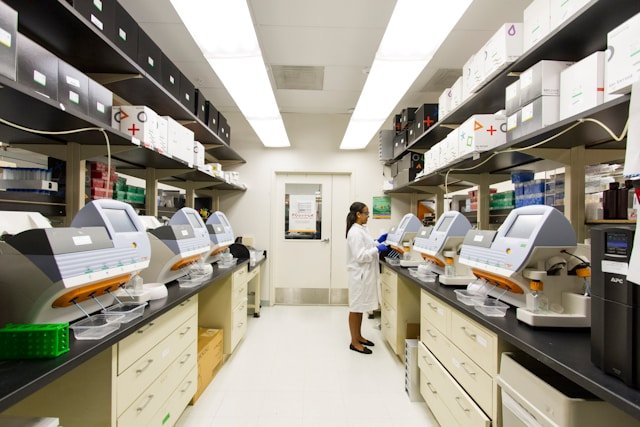What are the specific characteristics of laboratory furniture?

Laboratory furniture is a fundamental component of any scientific research environment, designed to support the unique requirements of various lab activities while ensuring safety, functionality, and efficiency. The specific characteristics of lab furniture are essential to creating a productive and safe laboratory space. This blog explores these characteristics in detail, highlighting the role of lab furniture manufacturers, the benefits of modular lab furniture, and the importance of laboratory planning and design, particularly in the context of turnkey laboratory solutions.
Durability and Chemical Resistance
One of the primary characteristics of lab furniture is its durability and resistance to chemicals. Laboratories often involve the use of corrosive substances, reagents, and solvents that can damage ordinary furniture. Therefore, lab furniture must be constructed from materials that can withstand harsh chemical environments.
- Material Selection: Lab furniture is typically made from high-quality materials such as stainless steel, phenolic resin, epoxy resin, and high-pressure laminates. These materials are chosen for their resistance to corrosion, heat, and chemical damage, ensuring long-term durability and easy maintenance.
- Surface Protection: Work surfaces are often treated with special coatings or finishes that provide an additional layer of protection against spills and splashes. These surfaces are designed to be non-porous and easy to clean, preventing the absorption of harmful chemicals and reducing the risk of contamination.
Ergonomic Design
Ergonomics is a critical factor in lab furniture design, as it directly impacts the comfort and efficiency of lab personnel. Properly designed furniture helps to minimize strain and injury, promoting a healthier and more productive work environment.
- Adjustable Features: Lab furniture manufacturers often include adjustable features in their designs. Height-adjustable workbenches, stools, and chairs allow users to customize their workspace according to their specific needs, reducing the risk of repetitive strain injuries and improving overall comfort.
- User-Friendly Design: Ergonomic lab furniture is designed with user-friendliness in mind. This includes features like rounded edges, easy-to-reach storage, and strategically placed controls and fixtures. These design elements help to create a workspace that is both safe and efficient.
Flexibility and Modularity
Flexibility is a key characteristic of modern lab furniture. The dynamic nature of scientific research requires lab environments to be adaptable to changing needs and projects. Modular lab furniture offers a versatile solution to this challenge.
- Modular Components: Modular lab furniture consists of interchangeable components that can be easily reconfigured to suit different tasks and setups. This flexibility allows laboratories to quickly adapt to new research requirements without the need for significant renovations or investments.
- Mobile Units: Mobile lab furniture, such as benches and storage units on casters, provides additional flexibility. These units can be easily moved and reconfigured, enabling researchers to optimize their workspace for different activities and collaborations.
Storage and Organization
Efficient storage and organization are essential characteristics of lab furniture. Proper storage solutions help to keep the laboratory neat and organized, reducing clutter and improving workflow efficiency.
- Specialized Storage: Lab furniture manufacturers design specialized storage solutions to accommodate various lab supplies and equipment. This includes chemical storage cabinets, reagent racks, and equipment shelving. These storage units are designed to provide easy access while ensuring the safe and secure storage of hazardous materials.
- Integrated Solutions: Modern lab furniture often includes integrated storage solutions, such as built-in drawers, cabinets, and shelving units. These integrated options help to maximize available space and keep essential items within easy reach, enhancing overall efficiency.
Safety Features
Safety is a paramount consideration in the design of lab furniture. Properly designed furniture can significantly enhance lab safety by reducing the risk of accidents and ensuring compliance with regulatory standards.
- Fire Resistance: Lab furniture must be designed to withstand potential fire hazards. This includes the use of fire-resistant materials and coatings, as well as the integration of fire safety features such as self-closing doors and automatic fire suppression systems in storage cabinets.
- Ventilation: Proper ventilation is crucial in maintaining a safe lab environment. Lab furniture, especially storage cabinets for chemicals and flammables, often includes built-in ventilation systems that help to remove harmful fumes and vapors, ensuring a safe working atmosphere.
- Spill Containment: Many lab furniture designs include features for spill containment, such as raised edges on work surfaces and integrated spill trays. These features help to contain accidental spills, preventing the spread of hazardous substances and facilitating easy cleanup.
Aesthetic and Functional Design
The aesthetic and functional design of lab furniture plays a significant role in creating a conducive working environment. A well-designed laboratory can enhance the overall productivity and morale of lab personnel.
- Modern Aesthetics: Contemporary lab furniture features sleek and modern designs that create a professional and inviting atmosphere. The use of high-quality materials, clean lines, and stylish finishes contributes to a positive working environment.
- Functional Layouts: Effective laboratory planning and design focus on creating functional layouts that optimize workflow and efficiency. This includes strategic placement of workstations, equipment, and storage to minimize movement and streamline lab activities.
Turnkey Laboratory Solutions
Turnkey laboratory solutions involve the comprehensive planning, design, and installation of lab furniture and equipment. These solutions are designed to provide a fully functional laboratory ready for immediate use, ensuring that all aspects of the lab are tailored to specific needs and standards.
- Comprehensive Planning: Turnkey laboratory solutions start with detailed planning and consultation. Lab furniture manufacturers work closely with clients to understand their requirements, research goals, and regulatory needs. This collaborative approach ensures that the final design meets all specifications and provides a functional, efficient workspace.
- Integrated Design and Installation: Turnkey solutions include the integrated design and installation of lab furniture, ensuring seamless coordination and implementation. This approach minimizes disruptions and ensures that all components work together harmoniously, creating a cohesive and functional laboratory environment.
- Customization and Flexibility: Turnkey laboratories are highly customizable, allowing for tailored solutions that meet the unique needs of different research disciplines. Whether it’s specialized storage, modular workstations, or advanced safety features, turnkey solutions provide the flexibility to create an optimal lab setup.
Importance of Laboratory Planning and Design
Effective laboratory planning and design are critical to creating a safe, efficient, and productive research environment. By considering the specific characteristics of lab furniture and integrating them into the overall design, laboratories can optimize their functionality and performance.
- Space Utilization: Proper planning ensures that space is used efficiently, with adequate room for equipment, workstations, and storage. Modular lab furniture helps to maximize available space by offering flexible and adaptable solutions.
- Workflow Optimization: A well-designed lab layout supports efficient workflows by positioning equipment and workstations in logical, easy-to-access locations. This reduces the time and effort required to move between tasks, enhancing overall productivity.
- Safety and Compliance: Incorporating safety features and ensuring compliance with regulatory standards is essential in lab design. By integrating advanced safety features into lab furniture and planning for proper ventilation and emergency access, labs can create a safer working environment.
- Collaboration and Flexibility: Modern laboratories often require collaborative spaces where researchers can work together on projects. Flexible and modular lab furniture supports this need by allowing spaces to be easily reconfigured for different team sizes and activities.
Conclusion
The specific characteristics of laboratory furniture are essential to creating a safe, functional, and efficient research environment. From durability and chemical resistance to ergonomic design and modular flexibility, modern lab furniture is designed to meet the unique demands of scientific research. By working closely with lab furniture manufacturers and incorporating these characteristics into laboratory planning and design, labs can create spaces that support innovation, safety, and productivity. Turnkey laboratory solutions offer a comprehensive approach to lab design, ensuring that every aspect of the lab is optimized for success.





